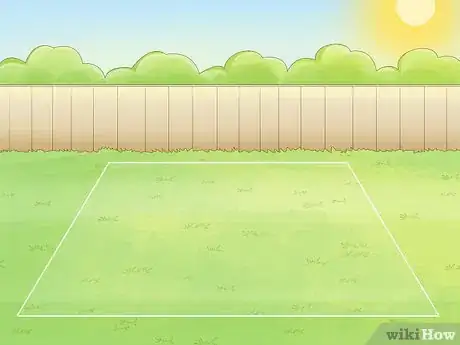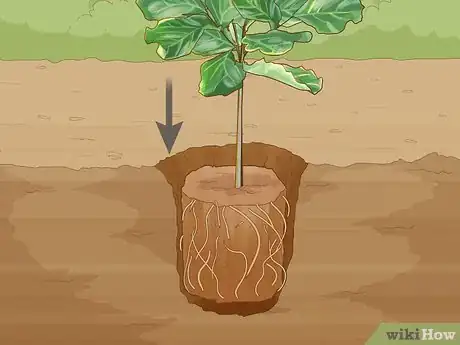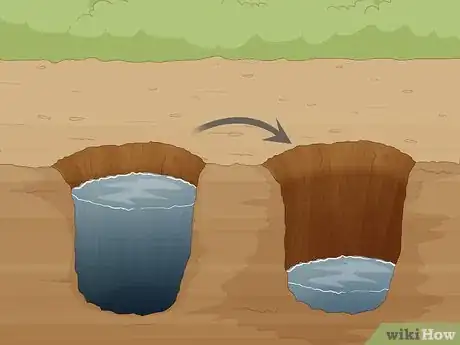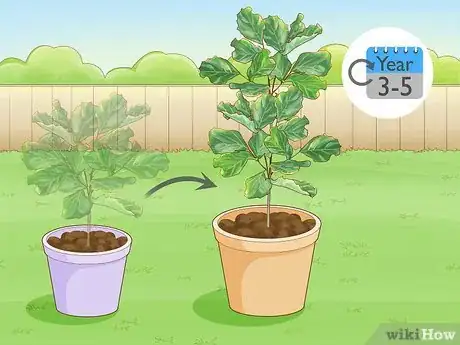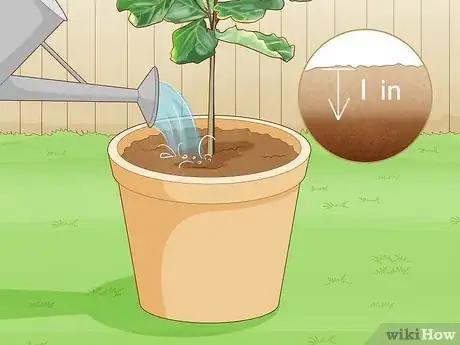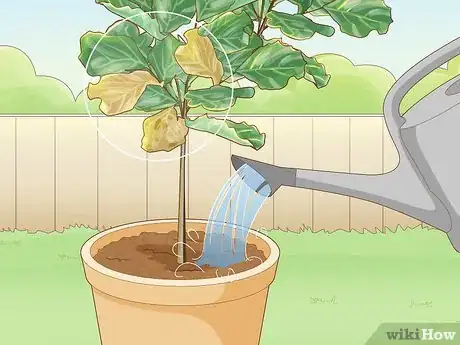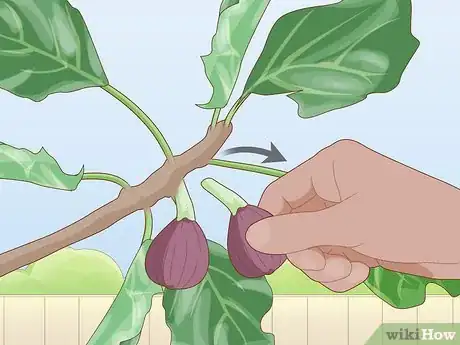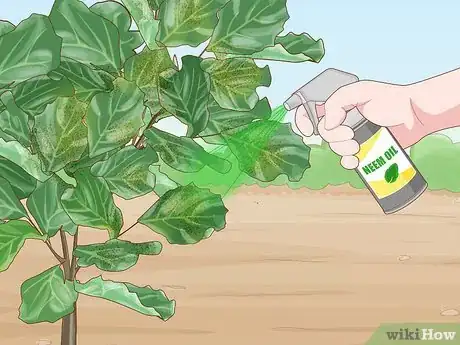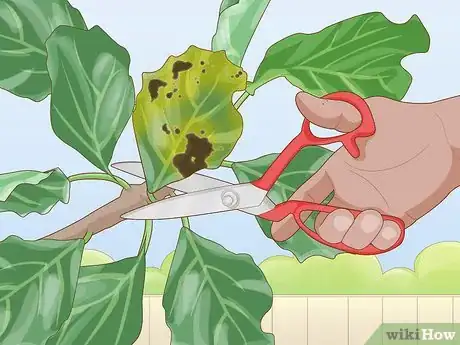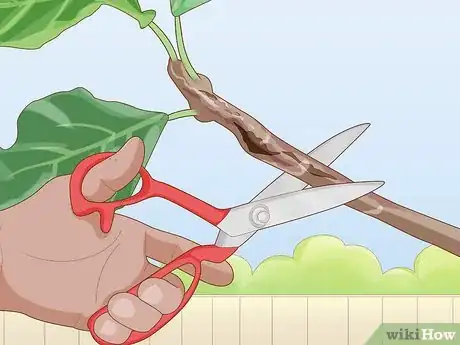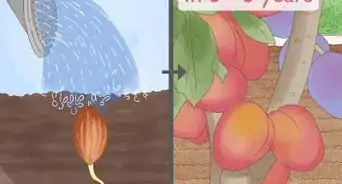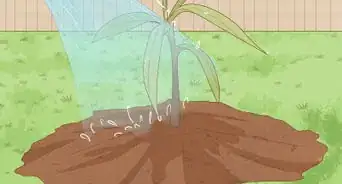This article was co-authored by Maggie Moran and by wikiHow staff writer, Kyle Hall. Maggie Moran is a Professional Gardener in Pennsylvania.
There are 12 references cited in this article, which can be found at the bottom of the page.
This article has been viewed 95,250 times.
The fig tree, also known as Ficus carica, is a hardy tree that produces sweet fruit, called figs. Fig trees aren't difficult to grow, but they can pose a challenge if you don't plant them in the right conditions or give them enough water. By following a few simple rules, you can keep your fig tree looking healthy and green.
Steps
Planting Your Fig Tree
-
1Choose a sunny spot to plant your fig tree. Fig trees need a lot of direct sunlight to thrive. Pick any spot in your yard that gets year-round sunlight. Make sure there aren't any nearby trees or structures that will block the sun from reaching your fig tree.[1]
-
2Plant your fig tree in a large plastic container if you live in a cold climate. If temperatures drop below 10 °F (−12 °C), fig trees buried in the ground may struggle to survive. Planting your fig tree in a plastic container will help shelter it from the cold. Use a large plastic patio container relative to the size of your fig tree.[2]
- If you do plant your fig tree in a plastic container, make sure you have somewhere sunny to put it.
Advertisement -
3
-
4
-
5Mulch the soil around your fig tree with 3 inches (7.6 cm) of compost. The compost will help the soil around your fig tree retain water. Do this whether your fig tree is planted in the ground or planted in a container.[7]
-
6Repot your fig tree every 3-5 years if it's planted in a container. Repot your fig tree during the winter. To repot your tree, remove about one-quarter of the soil in the pot. Then, pull your fig tree up out of the pot and cut away the large roots on the outside of the clump of roots. Place your fig tree back in the same pot and fill it in with soil. Pack the soil down with your hands.[8]
Watering Your Fig Tree
-
1Water your fig tree when the top 1 inch (2.5 cm) of soil is dry. Fig tree roots grow close to the surface of the soil, so it's important that you water the soil around your fig tree whenever it looks dry. Check the soil at least once a week to see if your fig tree needs more water.[9]
-
2Give your fig tree about 1 gallon (3.8 L) of water with each watering. Completely soak the soil around your fig tree. If you're not sure what 1 gallon (3.8 L) of water looks like, get a 1 gallon (3.8 L) bucket and fill it up with water. Then, pour the bucket of water over the soil around your fig tree.[10]
-
3Water your fig tree more if it's wilting or turning yellow. These are signs that your fig tree isn't getting enough water. If your fig tree exhibits these symptoms, increase the number of times you water it each week and see if that stops the wilting and discoloration.[11]
Fertilizing Your Fig Tree
-
1Fertilize your tree weekly with liquid fertilizer while fruit is growing on it. When you notice the fruit, apply a liquid fertilizer to the soil surrounding your fig tree. Use a liquid fertilizer that's high in potassium. Once you've harvested all the fruit on your fig tree, stop fertilizing it weekly.[12]
- You can use tomato plant fertilizer to fertilize your fig tree.
-
2Fertilize your tree weekly during spring and summer if it's in a container. Container-grown fig trees need more fertilizer to keep the limited supply of soil healthy. Rotate each week between a liquid fertilizer that's high in potassium and a general fertilizer. Add the fertilizer directly to the soil in the container.[13]
-
3Avoid fertilizing your fig tree more than necessary. Giving your fig tree too much fertilizer can cause excessive leaf growth. The extra growth will take energy away from the fruit on the tree, which can negatively impact your harvest. Only fertilize your fig tree once you notice fruit growing on it, or throughout the spring and summer if it's planted in a container. [14]
Harvesting Your Fig Tree
-
1Wait until the figs on your fig tree are ripe before you harvest them. You'll know they're ripe when they're drooping down from the branches they're growing off of. If a fig is still perpendicular to the branch it's growing off of, it's not ripe. Keep in mind that not all of the figs on your fig tree will ripen at the same time.[15]
- The figs on your fig tree should be ripe around late summer or early fall.[16]
-
2Use your hands to pick the ripened figs off your fig tree. Search the branches of your fig tree for a ripened fig. When you find one, grab it by the thin stem connecting the fig to the branch. Then, gently pull the stem away from the branch until it breaks off.[17]
- Carry a basket with you as you're harvesting your fig tree so you have something to put the figs in as you pick them off the tree.
-
3Put bird netting over your fig tree if birds are eating your figs. Wrap the netting over the branches of your fig tree and tie it off around the trunk. When you're ready to harvest some of your figs, untie the netting and lift it off the tree. When you're finished harvesting, put the netting back over your fig tree.[18]
- You can find bird netting online or at your local gardening center.
Preventing and Treating Common Diseases
-
1Spray your fig tree with neem oil to get rid of fig rust. Fig rust is a fungus that causes the leaves on fig trees to turn yellow and fall off. If you see signs of fig rust on your tree, spray neem oil over the roots and leaves once a week until the leaves stop yellowing and dropping.[19]
-
2Remove any leaves that show signs of having leaf blight. Leaf blight is a fungus that affects fig trees. Symptoms of the fungus include moist yellow spots, small holes in the leaves, and webs of fungus underneath the leaves. If you see signs of leaf blight, remove the infected leaves and dispose of them in the trash so the fungus doesn't spread.[20]
-
3Cut off branches that have a pink and white coating on them. This could be a sign that your fig tree is infected with a fungus called pink blight. It's important that you cut off infected branches so the fungus doesn't spread and kill your fig tree.[21]
- You can help prevent pink blight by removing a third of the smaller branches on your tree so it gets better air circulation.
Expert Q&A
Did you know you can get expert answers for this article?
Unlock expert answers by supporting wikiHow
-
QuestionHow often do you water a fig tree?
 Maggie MoranMaggie Moran is a Professional Gardener in Pennsylvania.
Maggie MoranMaggie Moran is a Professional Gardener in Pennsylvania.
Home & Garden Specialist
-
QuestionWhy are the leaves on my fig tree turning yellow and falling off?
 Maggie MoranMaggie Moran is a Professional Gardener in Pennsylvania.
Maggie MoranMaggie Moran is a Professional Gardener in Pennsylvania.
Home & Garden Specialist
-
QuestionDo fig trees like sun or shade?
 Maggie MoranMaggie Moran is a Professional Gardener in Pennsylvania.
Maggie MoranMaggie Moran is a Professional Gardener in Pennsylvania.
Home & Garden Specialist
References
- ↑ http://www.gardenersworld.com/how-to/grow-plants/how-to-plant-a-fig-tree/
- ↑ https://www.rodalesorganiclife.com/garden/how-to-grow-figs
- ↑ https://www.youtube.com/watch?v=1X0oPimr8j8&feature=youtu.be&t=41
- ↑ https://www.almanac.com/plant/figs
- ↑ https://www.rhs.org.uk/advice/grow-your-own/fruit/figs
- ↑ http://agebb.missouri.edu/agforest/archives/v10n2/gh14.htm
- ↑ https://www.rodalesorganiclife.com/garden/how-to-grow-figs
- ↑ https://www.rhs.org.uk/advice/profile?PID=106
- ↑ https://www.rodalesorganiclife.com/garden/how-to-grow-figs
- ↑ https://www.youtube.com/watch?v=9w-e4k-3Tz8&feature=youtu.be&t=530
- ↑ https://garden.org/plants/group/figs/
- ↑ https://www.rhs.org.uk/advice/profile?PID=106
- ↑ https://www.rhs.org.uk/advice/profile?PID=106
- ↑ https://www.rhs.org.uk/advice/profile?PID=106
- ↑ http://tallcloverfarm.com/351/how-to-know-when-a-fig-is-ripe-and-ready-to-pick
- ↑ https://www.rhs.org.uk/advice/profile?PID=106
- ↑ http://www.gardenersworld.com/how-to/grow-plants/how-to-harvest-figs/
- ↑ https://www.rodalesorganiclife.com/garden/how-to-grow-figs
- ↑ https://www.gardeningknowhow.com/edible/fruits/figs/common-fig-tree-diseases.htm
- ↑ https://www.gardeningknowhow.com/edible/fruits/figs/common-fig-tree-diseases.htm
- ↑ https://www.gardeningknowhow.com/edible/fruits/figs/common-fig-tree-diseases.htm
About This Article
The best way to care for a fig tree is to plant it in a sunny spot and water it whenever the soil around it looks dry. Water your fig tree with 1 gallon of water each time you water it. When your fig tree starts producing fruit, wait until the fruit is drooping on the branch before you harvest it. For more tips from our Horticulturist reviewer, including how often you should fertilize your fig tree and what to do if its leaves turn yellow, keep reading!
